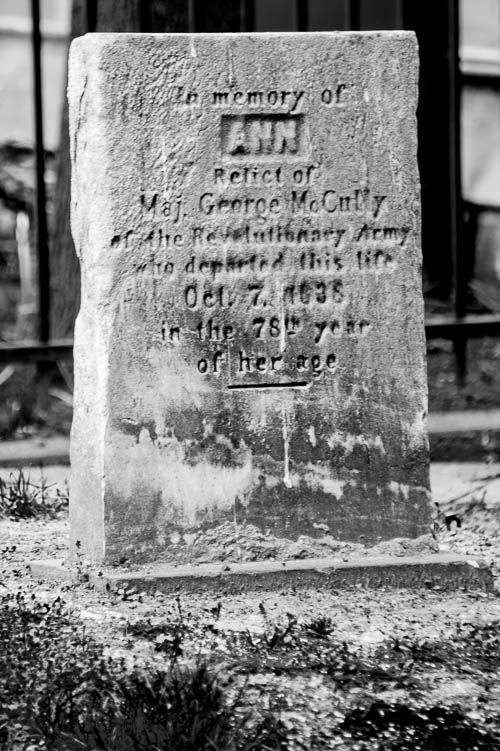
This grave marker at Trinity Cathedral in downtown Pittsburgh reads:
In Memory of
ANN
Relict of
Maj. Geroge McCully
of the Revolutionary Army
who departed this life
Oct. 7, 1836
in the 78th year
of her age
Places and Their People, History, and Lore

This grave marker at Trinity Cathedral in downtown Pittsburgh reads:
In Memory of
ANN
Relict of
Maj. Geroge McCully
of the Revolutionary Army
who departed this life
Oct. 7, 1836
in the 78th year
of her age
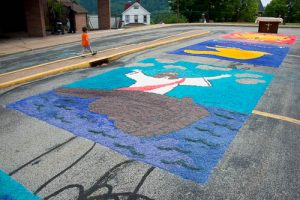
Holy Martyrs Parish in Tarentum marks the Feast of Corpus Christi by creating sawdust carpets in their parking lot each year.
It would not be fair of me to regurgitate the information that I just took off of another website about these sawdust carpets. So, if you want to know why and how the parish does this, you should Google it. I just did.
I live across the Allegheny River from Tarentum. However, I found out about these sawdust carpets less than a week ago, when my sister-in-law shared a Facebook post about this.
Here is what I personally noted about the tradition:
This past Thursday (May 31) was the Feast of Corus Christi. So, on today – Sunday – the parishoners of Holy Martyrs labored over their sawdust carpets. They worked all morning and afternoon on these in order to hold their vesper service in late afternoon.
I took my sister-in-law and her two small boys to Holy Martyrs at around 2 this afternoon. We chose this time because this was after the last Sunday mass.
We parked on the hill above the church since the parish makes its carpets IN their parking lot.
Then, we walked around the parking lot and looked at all of the finished and work-in-progress beauties.
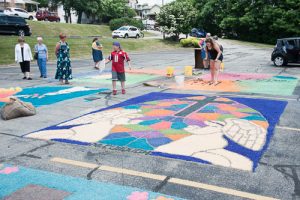
From what I understand about the tradition, the church held its vesper service in late afternoon. Then, they brushed over all of their sawdust masterpieces!
What traditions does your church celebrate?
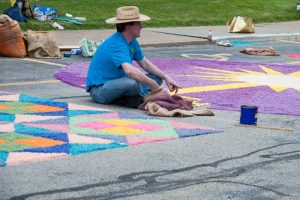
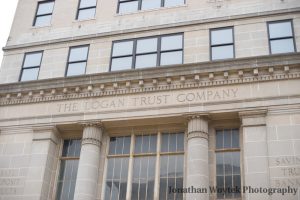
Vice President Aaron Burr shot and killed Alexander Hamilton.
Did he then hide out at the Logan Inn, mere blocks from present-day downtown New Kensington? Here in the land of Sheetz and the Black & Gold?
Or, did he flee to a different Logan Inn, in present day Flyers & Eagles Country?
Here is the link to Mrs. Luella Rodgers Frazier’s “The Early Years of New Kensington, Pennsylvania.” Halfway through this history, Frazier wrote that Alexander Logan owned the land that became Parnassus.
Frazier wrote that Aaron Burr stopped at Logan’s property “for a few days” after he dueled Alexander Hamilton. Per Frazier, “the Logans did not know about the duel and did not recognize Mr. Burr.”
As Frazier noted, Burr proceeded (by way of Pittsburgh) to Blennerhasset Island in the Ohio River.
Harman Blennerhasset owned the island and he allowed Burr, General James Wilkinson, and others to store men and supplies on the island in their bid to create a new nation in the southwest.
Burr’s accusers arrested Burr in Alabama. They chained him. (This, during a time when men chained their slaves. During a time when Burr’s own son-in-law owned a plantation.) The accusers brought Burr to Virginia in these chains. They tried him for treason.
Burr won his freedom by acquittal.
This follows the history and lore of Aaron Burr.
History buffs know about the Logan family’s prominence here. I even added to this blog post the photo that Jonathan took of the former Logan Trust Company in downtown New Kensington.
However, ANOTHER Logan Inn on the opposite side of PA – along Ferry Street in New Hope – also claims that THEY hosted Burr after the duel. The OTHER Logan Inn markets itself with Aaron Burr lore.
Perhaps Aaron Burr did in fact shelter at two Logan Inns, on opposite sides of the state. Perhaps both ends of the Pennsylvania Turnpike own this story.
What do you think?
Here’s my post from my other blog about the novel My Theodosia by Anya Seton.
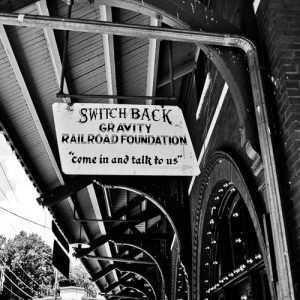
Have you ever heard of Mauch Chunk, Pennsylvania?
Well, then. Have you ever heard of Jim Thorpe, Pennsylvania?
In the 1950’s, the officials of Mauch Chunk renamed their borough “Jim Thorpe” after Olympic athlete Jim Thorpe. That whole story deserves its own blog post. (Or its own blog.)
The humans cognizant in the 1820’s still spoke of this Lehigh Valley town as “Mauch Chunk.” Many earned their livings from the coal mined above this town. In the 1820’s, they built the Switchback Gravity Railroad from these coal mines.
The railroad used gravity to transport the coal down the mountain, past Mauch Chunk. This “railroad” used mules to haul the empty coal cars back up the mountain.
Eventually the railroad offered rides to tourists on this gravity railroad. This inspired the first roller coaster at Coney Island.
If you want to read about Mauch Chunk ghosts, check out this post that I wrote on my other blog:
Here is a blog post that my sister wrote:
5 Reasons To Visit The Jim Thorpe This Halloween Season (or anytime)
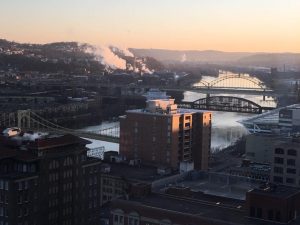
Good morning! Here’s the sunrise view from the window closest to my desk at my job in downtown Pittsburgh.
So, many years ago, a woman from my employer’s Manhattan office came to visit my co-workers here in our Pittsburgh office.
(I shall henceforth call her “the Manhattanite” even though she may live in Jersey, for all that I know.)
The Manhattanite looked out of our office’s windows onto downtown Pittsburgh.
( Maybe the Manhattanite looked out of this very window.)
The Manhattanite said, “My, my, my. That’s a regular little city out there!”
Why, yes, it is.
Do outsiders ever damn a place that you love with faint praise?
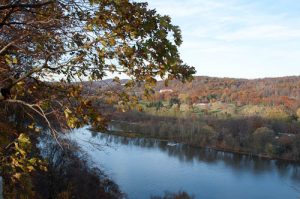
After the Johnstown Flood of May 31, 1889 killed at least 2,209 people, tourists took picnic lunches to Johnstown so that they could sight-see the damage.
People who lived along the Allegheny River (including the people of Parnassus) didn’t have to make this trip, though. The Johnstown Flood came to them.
You see, the South Fork dam upstream from Johnstown failed. The deluge wiped out several communities including downtown Johnstown and its surrounding neighborhoods. The debris washed downstream on the Conemaugh River.
Now, if you look at a map, you will see that we residents of Parnassus actually live downstream from Johnstown. Here’s why:
1.) The Little Conemaugh and Stoneycreek Rivers merge in downtown Johnstown (at Johnstown’s own “Point”) to form the Conemaugh River.
2.) The Conemaugh flows into the Kiski at Saltsburg.
3.) The Kiski flows into the Allegheny.
4.)About ten miles later the Allegheny flows past Parnassus (the city of New Kensington wasn’t founded until 1891), then past numerous other river towns such as Verona.
5.) Eventually the Allegheny meets the Monongahela at Pittsburgh to form the Ohio.
Here’s a passage from Chapter IX of Pulitzer Prize-winning (and Pittsburgh native) David McCullough’s “The Johnstown Flood,” about the aftermath of the flood:
The Allegheny River, with its endless freight of wreckage, also continued to be an immense fascination. Children were brought from miles away to watch the tawny water slip past the shores, so that one day they might be able to say they had seen something of the Johnstown Flood. The most disreputable-looking souvenirs, an old shoe, the side of a packing box with the lettering on it still visible, were fished out, dripping and slimy, to be carried proudly home.
There were accounts of the most unexpected finds, including live animals. But the best of them was the story of a blonde baby found at Verona, a tiny river town about ten miles up the Allegheny from Pittsburgh. According to the Pittsburgh Press, the baby was found floating along in its cradle, having traveled almost eighty miles from Johnstown without suffering even a bruise. Also, oddly enough, the baby was found by a John Fletcher who happened to own and operate a combination wax museum, candy stand, and gift shop at Verona.
Fletcher announced his amazing discovery and the fact that the baby had a small birthmark near its neck. Then he hired a pretty nineteen-year-old, dressed her in a gleaming white nurse’s uniform, and put her and the baby in the front window of his establishment. Within a few days several thousand people had trooped by to look at the Johnstown baby and, it is to be assumed, to make a few small purchases from the smiling Mr. Fletcher. Then, apparently, quite unexpectedly, the baby was no longer available for viewing. The mother, according to Fletcher, had lived through the flood and, having heard the story back in Johnstown, rushed to Verona, identified the birthmark, and went home with her baby.
So if this story is true, in the aftermath of the Johnstown Flood somebody fished a live baby out of the Allegheny River at Verona. (Verona is downstream from Parnassus and upstream from Pittsburgh.)
So, voyeurs may have stood on the ruins of Fort Crawford in Parnassus or on the adjoining grounds of the Presbyterian Church as the debris of demolished towns and demolished lives discharged past them. Perhaps a looky-loo climbed down the river bank here to fish a souvenir out of the Allegheny. Perhaps bodies washed ashore here.
I worked in downtown Johnstown for several years. Buildings there include plaques showing 1889’s high water mark and the downtown park features makers honoring the victims from Johnstown’s three deadliest floods (in 1889, 1936, and 1977). I often drove under the stone bridge that trapped many of the 1889 flood’s victims.
How sobering that the ruins of Johnstown coursed down the Allegheny, past all of these river towns on the way to Pittsburgh, in 1889.
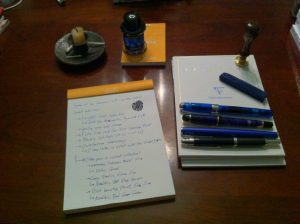
I am Jennifer Gaffron Woytek. You can call me Jenny. This is my new home for my blog about places (especially Pennsylvania) and their people, history, and lore.
In Greek mythology, the muses of music and poetry lived on Mount Parnassus.
Today, I live in the Parnassus neighborhood of New Kensington, Pennsylvania.
About Me:
I grew up in Perry and Somerset Counties. I graduated from Saint Vincent College in Latrobe. Then I moved to Johnstown for my first full-time job.
I visited New Kensington for the first time when I met my husband Jonathan in 2003. I found a job in downtown Pittsburgh. Then I moved to Parnassus to live in the 1890’s Victorian Queen Anne home that Jonathan and I are renovating.
Jonathan and I will continue to blog together on www.jennyandjonathangetmarried.com about our home projects and our family’s adventures.